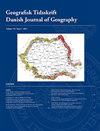Editorial: integrating local landscape management in a globalised world – practices and pathways
IF 1.1
4区 社会学
Q4 ENVIRONMENTAL STUDIES
Geografisk Tidsskrift-Danish Journal of Geography
Pub Date : 2016-01-02
DOI:10.1080/00167223.2016.1145553
引用次数: 0
Abstract
© 2016 The royal danish Geographical society CONTACT simon swaffield swaffies@lincoln.ac.nz Urbanisation, population growth, limited land and environmental concerns are putting the world’s farmers under growing pressure to increase productivity in sustainable ways (Lambin & Meyfroidt, 2011). Policy responses include seeking greater efficiency of production and distribution through globalisation of technologies (Coleman, Grant, & Josling, 2004), intensification of farming systems (Reenberg & Fenger, 2011; Rudel et al., 2009), integration of global food networks (Dickson-Hoyle & Reenberg, 2009; Ericksen, 2008) and creation of more open markets (Anderson & Josling, 2005). At the same time, sustainability scientists warn of the environmental risks and consequences of agricultural intensification (Tilman, Cassman, Matson, Naylor, & Polasky, 2002); urban consumers demand higher moral and environmental standards in their food supply (Morgan, Marsden, & Murdoch, 2007); and society requires a growing range of material and non-material ecosystem services from production landscapes (Wratten, Sandhu, Cullen, & Costanza, 2013). At the local landscape level, farmers manage land as producers, owners and citizens (Primdahl & Kristensen, 2011; Primdahl, Kristensen, & Busck, 2013b). The way they do this and how they combine the three roles depends on the nature and locality of the biophysical landscape, the farmer’s own situation (full-time farmer, tenant farmer, lifestyle farmer and employed farm workers), the local community (or lack of it), the impacts of urbanisation upon peri-urban and rural landscapes (Orsini, 2013; Primdahl, Kristensen, & Swaffield, 2013a; Zasada, Fertner, Piorr, & Nielsen, 2011) and the farmers’ relationships with the wider market trends and policy agenda (Plieninger & Beiling, 2012; Primdahl & Swaffield, 2010). Thus, the ways that agricultural landscapes are structured and function vary enormously, even within the developed world, and these diverse processes and relationships raise significant policy design and implementation questions about how to effectively integrate efficient global food supply systems with sustainable management of local landscapes as settings for living, working and service provision (Primdahl & Swaffield, 2010; Primdahl et al 2013b; Swaffield & Primdahl, 2014; Termorshuizen & Opdam, 2009). One common feature, however, is that the links between local landscapes and the rest of the world are becoming increasingly complex and interrelated (BirchThomsen & Kristensen, 2005; Mertz, Wadley, & Christensen, 2005). Globalisation means that decisions and practices in particular landscapes become relatively less related to local and regional contexts, and increasingly linked to (affecting and affected by) decisions and practices in other distal landscapes (Reenberg & Primdahl, 2009). Land use in an urbanised world is becoming telecoupled (Seto & Reenberg, 2014), and local landscapes increasingly become linked to multi-dimensional networks organised as non-nested hierarchies (Swaffield & Primdahl, 2006). As a consequence of this, the relationships between local landscape management practices and market processes, public policies and business decisions occurring at other scales become disjointed and asymmetrical. This in turn means that policy problems associated with local agricultural landscapes become harder to define, with neither straightforward nor ‘optimal’ solutions. In short, they become ‘wicked’ problems (Rittel & Webber, 1973).社论:在全球化世界中整合地方景观管理——实践和途径
©2016丹麦皇家地理学会CONTACT simon swaffield swaffies@lincoln.ac.nz城市化、人口增长、有限的土地和环境问题正使世界农民面临越来越大的压力,必须以可持续的方式提高生产力(Lambin & Meyfroidt, 2011)。政策回应包括通过技术全球化寻求更高的生产和分配效率(Coleman, Grant, & Josling, 2004),农业系统集约化(Reenberg & Fenger, 2011;Rudel et al., 2009),全球食品网络整合(Dickson-Hoyle & Reenberg, 2009;Ericksen, 2008)和创造更开放的市场(Anderson & Josling, 2005)。与此同时,可持续发展科学家警告了农业集约化的环境风险和后果(Tilman, Cassman, Matson, Naylor, & Polasky, 2002);城市消费者在食品供应方面要求更高的道德和环境标准(Morgan, Marsden, & Murdoch, 2007);社会需要从生产景观中获得越来越多的物质和非物质生态系统服务(Wratten, Sandhu, Cullen, & Costanza, 2013)。在地方景观层面,农民以生产者、所有者和公民的身份管理土地(Primdahl & Kristensen, 2011;Primdahl, Kristensen, & Busck, 2013)。他们这样做的方式以及他们如何将这三种角色结合起来取决于生物物理景观的性质和地点、农民自己的情况(全职农民、租客农民、生活方式农民和受雇的农场工人)、当地社区(或缺乏社区)、城市化对城郊和农村景观的影响(Orsini, 2013;Primdahl, Kristensen, & Swaffield, 2013;Zasada, Fertner, Piorr, & Nielsen, 2011)以及农民与更广泛的市场趋势和政策议程的关系(Plieninger & Beiling, 2012;Primdahl & Swaffield, 2010)。因此,即使在发达国家,农业景观的结构和功能方式也存在巨大差异,这些不同的过程和关系提出了重要的政策设计和实施问题,即如何有效地将高效的全球粮食供应系统与当地景观的可持续管理结合起来,作为生活、工作和服务提供的环境(Primdahl & Swaffield, 2010;Primdahl等2013;Swaffield & Primdahl, 2014;Termorshuizen & Opdam, 2009)。然而,一个共同的特征是,当地景观与世界其他地区之间的联系正变得越来越复杂和相互关联(BirchThomsen & Kristensen, 2005;Mertz, Wadley, & Christensen, 2005)。全球化意味着特定景观中的决策和实践与当地和区域背景的相关性相对较低,而与其他远端景观中的决策和实践的联系(影响和影响)越来越多(Reenberg & Primdahl, 2009)。城市化世界中的土地利用正变得远耦合(Seto & Reenberg, 2014),当地景观越来越多地与以非嵌套层次结构组织的多维网络联系在一起(Swaffield & Primdahl, 2006)。因此,当地景观管理实践与市场过程、公共政策和其他尺度上的商业决策之间的关系变得脱节和不对称。这反过来意味着与当地农业景观相关的政策问题变得更加难以定义,既没有直接的解决方案,也没有“最佳”的解决方案。简而言之,它们变成了“邪恶的”问题(Rittel & Webber, 1973)。
本文章由计算机程序翻译,如有差异,请以英文原文为准。
求助全文
约1分钟内获得全文
求助全文
来源期刊
CiteScore
5.20
自引率
0.00%
发文量
5
期刊介绍:
DJG is an interdisciplinary, international journal that publishes peer reviewed research articles on all aspects of geography. Coverage includes such topics as human geography, physical geography, human-environment interactions, Earth Observation, and Geographical Information Science. DJG also welcomes articles which address geographical perspectives of e.g. environmental studies, development studies, planning, landscape ecology and sustainability science. In addition to full-length papers, DJG publishes research notes. The journal has two annual issues. Authors from all parts of the world working within geography or related fields are invited to publish their research in the journal.

 求助内容:
求助内容: 应助结果提醒方式:
应助结果提醒方式:


